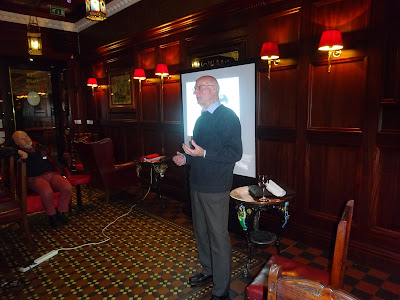Our cercle family gathered at its last meeting to learn about our long-standing member Claudine's ville natale, Bourges. Claudine, a Berryuère by birth, talked about her cradle days in this city in central France where both her grandmothers lived in the same street. Although her family would later move to Blois in the Loire Valley, a theme of one of her earlier talks, she returned to Bourges for the civil celebration of her marriage with husband, Seamus. Then this summer, they both headed back to the city as Claudine felt it was about time to get to know better the place where she was born.
During her talk, Claudine traced the Celtic origins of the city from its beginnings as Avaric in Gaul through the Roman conquest in 52 BC to the establishment of
Avaricum, the capitol of Aquitaine Première and eventually becoming a medieval Royal City. She explained how the first Archbishop began construction of churches and Romanesque cathedrals, whose foundations were to remain as important monastic settlements up to the Revolution.
A short video presentation around the ramparts of the city led us to Claudine's personal pictures and impressions of the
Saint Etienne Cathédrale, built from 1195 to mainly the late-13 century, culminating in the award of Unesco World Heritage site in 1992. In this part of her presentation she picked out several architectural features including the very unusual absence of a transept.
Claudine's chronology concentrated on important characters associated with Bourges and included such VIPs as
Duc Jean de Berry,
Charles VII from the House of Valois and
Jacques Cœur. This latter had become Controller of the Royal Purse but fell out of favour with the King who accused him of poisoning his mistress and sentenced him to death. Jacques Cœur avoided execution by escaping to the protection of the Pope but later died in disgrace on the Greek Island of Chios.
We were next escorted to the centre of Bourges as Claudine shared with us a selection of views of the 400 odd protected houses in the vicinity of
Place Gordaine where several stone and half-timbered houses still stand side-by-side. Other stops en route were the
Hotel Cujas, now the Musée de Bourges and the Passage Casse-Cou, a break-neck construction built over a Gallo-Roman wall.
As the talk progressed we stepped into Renaissance Bourges and forward as it revealed itself as a City of Culture, attracting students to its university, among them a young Jean Calvin from Picardie.
Claudine went on to target the development of Bourges as a military and industrial city in the late-19th century and when considering its more recent past pinpointed two more landmarks, le Château d'eau and the Maison de la Culture, the first in France inaugurated by André Malraux accompanied on the occasion by then Président Général Charles de Gaulle. As an aside Claudine noted that many cultural activities are now managed by private concerns with less use made now of the nationalised Maisons de Culture.
Claudine's presentation incorporating elements of son et lumière was ably assisted and managed by her husband, Seamus and as it drew to a close it was soon time to provide a token of appreciation for a carefully researched and affectionate appreciation of this lovely city in Central France.
Our président, noting that he himself was an adopted Berrichon having spent his year's assistantship in the Cher department, remarked that his close friend Daniel who lives near Bourges had called on the esteemed local wine maker,
Eric Louis to mark the connection between Claudine and the region.
Eric Louis produces wines in Thauvenay, quite close to Bourges and Claudine was duly presented with a personalised gift card,
an apron from the domaine and a locally available bottle of Eric Louis wine. They both, after all, share the same terroir.
Un très grand merci à Claudine et Seamus et nos remerciements aussi à Daniel et au Domaine Éric Louis.





